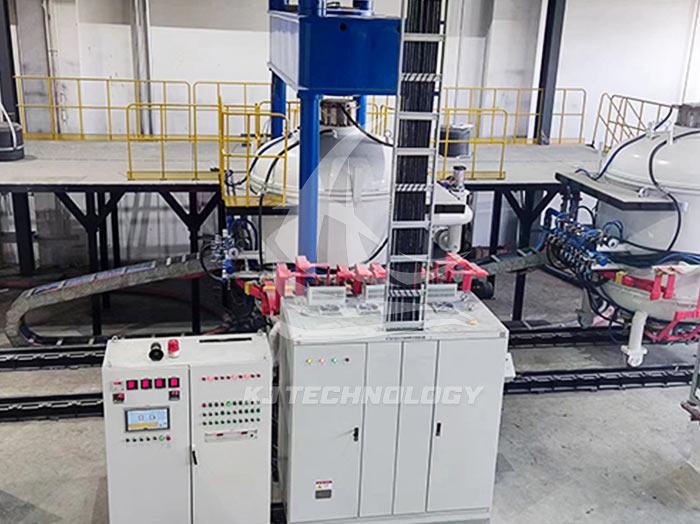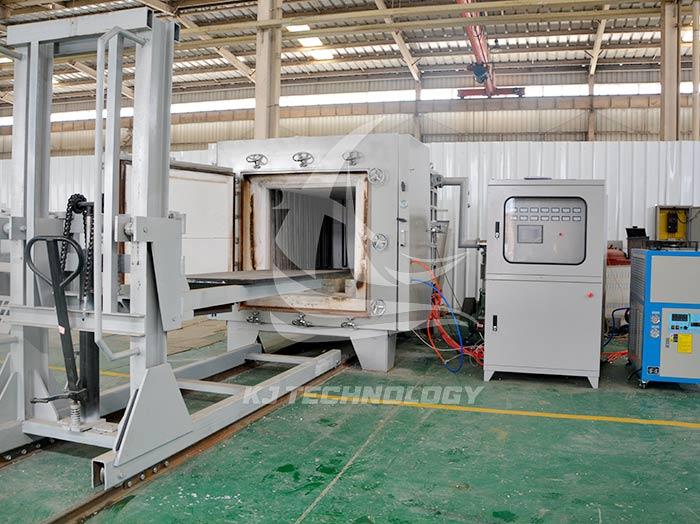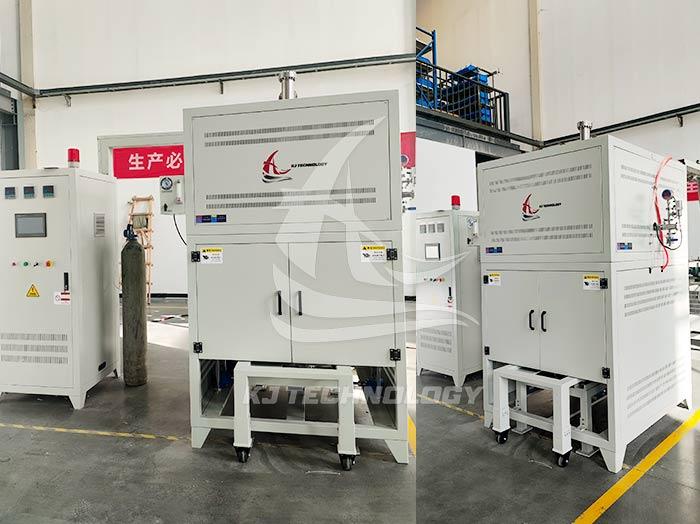Atmosphere vacuum sintering furnace
 05-29-2025 Author: KJ technology
05-29-2025 Author: KJ technology
Atmosphere vacuum sintering furnace is a high-end heat treatment equipment that combines vacuum technology and atmosphere control technology, with unique advantages and wide applications. The following introduces its principles, advantages, application fields, structural composition, and operating points:
Principle
Vacuum environment effect: Place the material in the furnace, evacuate the furnace to a vacuum state, and then heat the furnace to reach a high temperature state for chemical reactions and crystallization. During this process, the quality and performance of the product can be controlled by adjusting parameters such as temperature, vacuum degree, and pressure.
Atmosphere control function: By controlling the atmosphere inside the furnace, the sintering and hardening of materials can be achieved. Under high temperature and suitable atmosphere, the powder particles in the material will continuously migrate, the grain boundaries will move accordingly, the pores will gradually be eliminated, and shrinkage will occur, making the green body a dense ceramic body with certain strength.
Advantage
Improving material purity: It can create and maintain a highly clean vacuum environment, avoiding the common drawbacks of traditional heating methods such as oxidation, decarburization, and carburizing, and avoiding the influence of impurities on material properties.
Precise control of atmosphere: It has the ability to precisely control the atmosphere inside the furnace. By introducing inert gases (such as argon, nitrogen, etc.) or other specific gases into the furnace, the heat treatment atmosphere of the material can be further adjusted to meet the special requirements of different materials for the atmosphere.
Improving thermal efficiency: By adopting advanced vacuum technology, rapid heating and melting of materials can be achieved at lower temperatures, greatly improving thermal efficiency and reducing energy waste. Compared to traditional stoves, the heating speed can be increased several times, thereby shortening the production cycle and improving production efficiency.
Accurate temperature control: Equipped with advanced temperature control systems and highly sensitive temperature sensors, it can achieve precise monitoring and adjustment of the temperature inside the furnace. Whether it's rapid heating at high temperatures or stable insulation at low temperatures, it can be easily handled.
High safety: The fully enclosed vacuum environment avoids the occurrence of dangerous factors such as high temperature and high pressure, reducing the possibility of accidents. During the operation, an automatic control system is used to monitor real-time parameters such as temperature and pressure inside the furnace, ensuring the safety of the operation.
Environmentally friendly and pollution-free: No waste gas, waste residue or other pollutants are generated during the heating process, making it environmentally friendly.
Strong adaptability: The characteristic of heating under vacuum environment allows it to adapt to the melting point, vapor pressure and other parameters of different materials, achieving the melting and preparation of various materials.
High degree of intelligence: equipped with RS-485 communication interface and data management software, it has the function of paperless recording of historical data and temperature rise curves, correcting temperature deviation errors, and can manage multiple devices and remotely diagnose and analyze faults.
Application area
Preparation of Metal Materials: Used for preparing high-purity metal materials such as steel, titanium alloys, aluminum alloys, as well as composite materials such as metal ceramic composites and metal matrix composites.
Preparation of Semiconductor and Electronic Materials: Used for preparing semiconductor and electronic materials, such as optical fiber materials, optical glass, etc., by eliminating impurities and bubbles in the materials, high-quality optical materials can be obtained.
Ceramic product preparation: used for preparing high-temperature ceramic products, such as ceramic tiles, ceramic pipes, etc.
Preparation of new energy materials: used for the preparation of lithium-ion battery materials, fuel cell materials, etc., to meet the demand for high-performance materials in the field of new energy.
In the fields of scientific research and military industry, it also plays an important role in the preparation of refractory alloys such as tungsten, molybdenum and their alloys through powder forming and sintering.
Structural composition
Furnace body: It is the main structure of the equipment, providing a closed space for the sintering process.
Heating chamber: an area where materials to be sintered are placed and heated.
Vacuum system: used to evacuate the furnace into a vacuum state, creating an oxygen free environment for sintering.
Gas filling and discharging system: It can introduce the required atmosphere gas into the furnace and control the flow rate and pressure of the gas.
Air cooled circulation system: Helps to evenly distribute the temperature inside the furnace and cool the equipment.
Electronic control system: controls the operating parameters of equipment, such as temperature, vacuum degree, atmosphere, etc.
Pneumatic system: assists in achieving some mechanical actions, such as opening and closing furnace doors.
Water cooling system: cools some key components to prevent overheating and damage.
Material cart: used to feed assembled workpieces into the furnace.
Operation point
Loading: Load the materials to be sintered into the furnace according to the requirements, paying attention to the placement and position of the materials to ensure the uniformity of sintering.
Vacuuming: After closing the furnace door, start the vacuum system to evacuate the air inside the furnace to the desired vacuum level.
Atmosphere control: According to the sintering requirements of the material, an appropriate amount of atmosphere gas is introduced into the furnace through a gas filling and discharging system, and the flow rate and pressure of the gas are controlled.
Heating and insulation: Set the heating temperature curve, start the heating system, raise the temperature inside the furnace according to the set curve, and maintain a constant temperature during the insulation stage to ensure that the material undergoes sufficient chemical reactions and crystallization.
Cooling: After sintering, the furnace is cooled through a cooling system to gradually cool the material to room temperature. The cooling rate needs to be controlled according to the characteristics of the material to avoid defects such as cracks.








